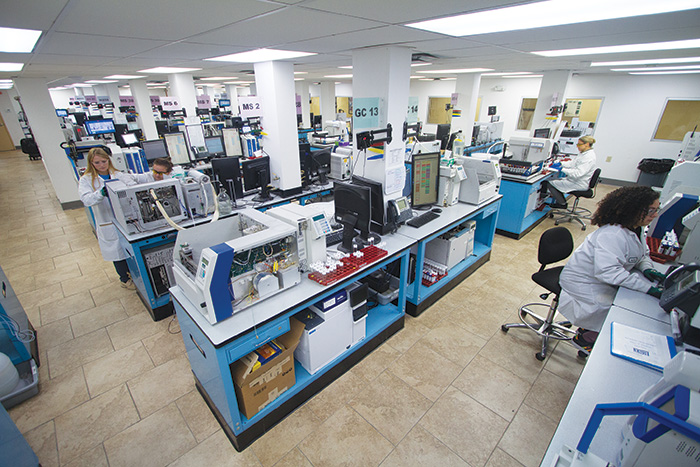While the battle over PFAS in landfills is far from over, with continued research, collaboration, and innovation, waste management professionals can play a crucial role in protecting the environment and public health.
By Lindsay Boone
Per- and polyfluoroalkyl substances (PFAS) contamination in landfills is a pressing issue that is increasingly demanding the attention of waste management professionals. This article provides a comprehensive overview of PFAS in landfills, including the paths PFAS travel into and out of landfills, the regulatory landscape for PFAS in landfills, and the crucial role waste management professionals will play in solving the PFAS puzzle.
The Problem with PFAS
Per- and polyfluoroalkyl substances (PFAS) are a class of synthetic compounds first invented in the 1930s and mass-produced since the 1940s. Today, there are thousands of PFAS compounds known to exist, found in household-name brands like Teflon and Scotchgard. These nearly ubiquitous compounds are used to produce a wide range of products from non-stick coatings to stain- and water-resistant fabrics, to the Class B foams used to fight chemical fires.
Despite their quality-of-life benefits, there are downfalls that come with PFAS. The same properties that make them so useful—resistance to heat, water, and oil—also make them nearly indestructible. Furthermore, PFAS are bioaccumulative, meaning they can build up in living organisms—both plants and animals. Exposure to certain PFAS has been linked to health risks like cancer, liver damage, and fertility issues.
The PFAS Path
PFAS are introduced into landfills through the disposal of consumer and industrial products containing these chemicals. As moisture from liquid waste, rain, and condensation percolates through landfill waste, it picks up PFAS and collects as leachate.
Leachate from unlined or poorly lined landfills can seep directly into the local environment, making its way into groundwater and surface waters. These waters are often used as sources for drinking water, so this is one of the ways people can unknowingly be exposed to PFAS.
If the landfill has a leachate collection system, this leachate is typically sent to a local wastewater treatment facility. Unfortunately, traditional wastewater treatment does not remove PFAS, and discharge from these facilities can also introduce PFAS into the environment.
Biosolids also present a challenge for waste management professionals. Commonly referred to as sewage sludge, biosolids are a byproduct of wastewater treatment. If the water being treated contains PFAS, the biosolids produced are likely to as well. These biosolids are often sent to landfills, starting the PFAS contamination cycle all over again.

Photos courtesy of PACE.

A Bird’s Eye View of the PFAS Regulatory Landscape
The EPA has considered PFAS to be compounds of concern for years, and multiple programs are being used to monitor and control PFAS contamination. While many of these programs are not directly tied to landfills, it is important to remember that when elevated levels of PFAS are found, regulators and health officials may call on landfill operators to collaborate on solutions.
Understanding the big picture can help waste management leaders be prepared.
For example, the EPA’s Unregulated Contaminant Monitoring Rule (UCMR) is designed to collect data on contaminants suspected to be present in drinking water, but with no health-based standards set under the Safe Drinking Water Act (SDWA). Every five years, the EPA evaluates and revises a list of up to 30 compounds to be monitored under UCMR.
Six PFAS made their first appearance on this list under UCMR 3 in 2012:
1. Perfluorooctane sulfonic acid (PFOS)
2. Perfluorooctanoic acid (PFOA)
3. Perfluorononanoic acid (PFNA)
4. Perfluorohexane sulfonic acid (PFHxS)
5. Perfluoroheptanoic acid (PFHpA)
6. Perfluorobutanesulfonic acid (PFBS)
The EPA dedicated UCMR 4 to studying other compounds of concern, but in late 2021, the agency announced that PFAS would take up 29 of the 30 spots under UCMR 5. (The last was reserved for lithium.) Sampling under UCMR 5 will take place between 2023 and 2025.
In March 2023, the EPA also issued an Advanced Notice of Proposed Rulemaking (ANPRM) to set Maximum Contaminant Levels (MCLs) for six PFAS in drinking water: PFOA, PFOS, PFHxS, PFNA, PFBS, and Hexafluoropropylene oxide dimer acid (HFPO-DA), commonly referred to as GenX Chemicals. Five out of the six PFAS with proposed MCLs were the same as those that were monitored under UCMR 3.
In 2022, the EPA issued another ANPRM, proposing to designate PFOA and PFOS as hazardous chemicals under CERCLA. Then, in April 2023, the EPA solicited public comments on the proposed designation of seven additional PFAS compounds, their precursors (as well as precursors to PFOA and PFOS), and categories of PFAS that share one or more similar characteristics, such physical and chemical properties, chemical structure, or toxicological action. Originally intending to finalize the designation in 2023, they have since pushed the target date to February of 2024.
It is important for waste management professionals to understand that CERCLA grants the EPA the authority to order responsible parties to clean up sites contaminated with the designated chemicals. However, in a series of CERCLA PFAS Enforcement Listening Sessions held in March, the EPA specifically called out landfills as a type of entity for which the EPA would use “enforcement discretion.”
One regulatory action specific to landfills involves the EPA’s Effluent Guidelines Program. Effluent Guidelines (also referred to as Effluent Limitations Guidelines, ELGs) are national regulatory standards for the treatment and control of wastewater discharged to surface waters and municipal sewage treatment plants. After finding PFAS in the leachate from 95 percent of landfills, the EPA determined that ELGs were warranted for the landfill sector. These ELGs have yet to be announced.
Before leaving the ever-evolving PFAS regulatory landscape, it should also be noted that states are taking action to monitor and control PFAS. Some have set limits on PFAS concentrations in drinking water and groundwater, while others have established guidelines for managing PFAS-containing waste. Additionally, several states have banned certain PFAS chemicals in products and prohibited PFAS-laden biosolids from being sent to landfills or land-applied as soil amendments. For example, in 2022, Maine passed a law that prohibits the land application of biosolids and the sale of compost or other agricultural products and materials containing sewage sludge in an effort to limit PFAS contamination.
Solving the PFAS Challenge
The pace of change in PFAS regulations is being matched by new developments and tools, which should help waste management professionals manage the risk of PFAS in their landfills.
First, the voluntary and mandatory phase-out of the use and production of PFAS by industry will help reduce the amount of PFAS that ends up in landfills. PFOA and PFOS were voluntarily phased out in the U.S. in the early 2000s. Then in late 2022, 3M, a major producer and user of PFAS, announced that they planned to phase out the production of all PFAS and discontinue their use across their entire product portfolio by the end of 2025. Some retailers, such as REI, Dick’s Sporting Goods, and Loews, have also announced their intent to stop selling products with intentionally added PFAS.
Additionally, new tools are in development to help monitor and remove PFAS wherever it can be found. PFAS makes its way to landfills in many matrices which are difficult to test, such as wastewater sludge and leachate. The EPA’s Draft Method 1633 is a promising development in the effort to monitor and regulate PFAS from landfills. This method will help regulatory agencies measure PFAS concentrations in leachate, biosolids, and solid waste, providing critical data to inform decision-making and enforcement actions.
While Draft Method 1633 will help waste management professionals assess the extent of their issues with PFAS, solving the challenge of PFAS in landfills will ultimately require contributions from multiple angles.
Technologies such as advanced oxidation processes, adsorption, and membrane filtration may be able to help remove PFAS from landfill leachate before it is sent to the public treatment works. Research is also underway to develop methods for destroying PFAS in various sample matrices such as leachate and biosolids, potentially reducing the risk of contamination when these materials are land-applied or sent to landfills.
The battle over PFAS in landfills is far from over, but with continued research, collaboration, and innovation, waste management professionals can play a crucial role in protecting the environment and public health. | WA
Lindsay Boone is a Technical Specialist with PACE Analytical. Her primary focus for the past several years has been on PFAS. She has worked with numerous drinking water and wastewater professionals on a wide array of PFAS related issues such as sampling techniques, lab report interpretation, and analytical methodology selection. Lindsay has worked at various environmental laboratories, life sciences, and analytical instrumentation manufacturer companies. Lindsay can be reached at [email protected].
